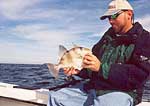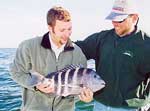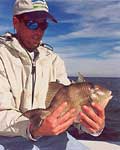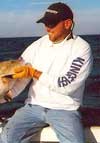Crabs, Convicts and Triggerfish

By Capt. Richie Lott
If you can't stand the cold, you may want to bundle up, grin and bear it and
slip on a pair of Gloves. It's cold, but the fish are biting within 10 Miles of
our beautiful Georgia beaches. And, the best part of the deal? You can make the
ride in less than ideal conditions when fishing on close in structure.
Crabs on the Hook!
 Using
small fiddler crabs as bait can be a task if you don't know where to pick them
up or purchase them. Lucky for us that day, our local source had plenty of the
pinching devils. At a cost of five bucks per hundred, I stocked up and bought
400 crabs. Beats digging all day with a shovel in the mud. However, the extreme
cold will send these critters DEEP into the ground, and no one will be able to
find them without using a Backhoe! Using
small fiddler crabs as bait can be a task if you don't know where to pick them
up or purchase them. Lucky for us that day, our local source had plenty of the
pinching devils. At a cost of five bucks per hundred, I stocked up and bought
400 crabs. Beats digging all day with a shovel in the mud. However, the extreme
cold will send these critters DEEP into the ground, and no one will be able to
find them without using a Backhoe!
Even the commercial vendors will have problems and they know all the tricks
on the book. The crabs you do have on hand should be cherished and keeping them
alive for extended periods is not a big chore. Just keep them out of the cold
as much as possible. Mine stay in my office for the short life they have in their
new heated condo with a lid. I use a 48-quart cooler with just a thin layer of
dirt in the bottom, and give them a light mist of water with a spray bottle twice
a day. Feed them grits, keep their new home clean and they'll live for weeks.
I never go nearshore wreck fishing in Winter or Spring without taking along
a minimum of 200 crabs, especially when the anglers on board are not used to this
sport. You can be robbed of your bait without a nibble, and most people new to
using crabs for bait find it quite frustrating until a FEEL is acquired.
For those who don't know how to thread one on the hook, I'll explain it. Very
gently drive the barb of the hook through the bottom of the crab until the point
comes through the top of the shell. Then, you're all set.
Short Run… Quality Fish
 After
a short 30 - minute run from Golden Isles Marina on St. Simons Island, we crept
up to our structure in 40 ft. and tossed out the wreck marker on the down current
side of the structure. As I made passes to determine which marking looked best,
I noticed TONS of fish on the East End of the structure consistently. So, we anchored
the CNILE directly over it. After
a short 30 - minute run from Golden Isles Marina on St. Simons Island, we crept
up to our structure in 40 ft. and tossed out the wreck marker on the down current
side of the structure. As I made passes to determine which marking looked best,
I noticed TONS of fish on the East End of the structure consistently. So, we anchored
the CNILE directly over it.
There wasn't a rig tied on or a leader made, so we spent 15 minutes of quality
fishing time making rigs. When fishing shallow water wrecks with light tackle,
I prefer a certain rig. I like a 3 oz. Weight on the main line, a swivel and 2-ft.
of 20-pound leader with a 1/0 live bait hook.
As the last rig was tied, I looked once again at the marking on the bottom
machine to be sure we were still on the mark to prevent an unproductive drop.
I liked what I saw, so, "Drop 'em, Boys" I said.
It was only seconds passed when everyone on the boat was hooked up with good
fish. I breathed a sigh of relief, looked up at that Full Moon in the sky, and
said thank you! We had prepared too much for this trip for ANYTHING to go wrong,
including the fish NOT biting!
The first three fish over the gunwale were impressive. Two nice Triggerfish
and a nice Sheepshead, or "convict fish" as we call them. Believe me,
they wear their stripes well, as they are notorious bait thieves.
Each drop produced more nice fish. It was a premier day on the CNILE once again.
Our final tally went something like this. After 90 Sheepshead were caught and
released, I lost count of them. We were on the fish another hour after that, so
I would guess around 40 more. We ended up fairing well on the Triggerfish, too.
A total of 12 Triggers caught and released were more than ample for the crew and
myself.
 A
few of the Sheepshead were QUALITY size fish. We had to get the net out on several
occasions due to the size of some of them. These guys fight extremely dirty and
they don't give up. In fact, a large fish fooled me that afternoon. I had hooked
the fish, and figured he was a decent fish, but not too big. As I tossed my cigar
into the trash bucket, I held the rod in one hand for a split second. Huge mistake! A
few of the Sheepshead were QUALITY size fish. We had to get the net out on several
occasions due to the size of some of them. These guys fight extremely dirty and
they don't give up. In fact, a large fish fooled me that afternoon. I had hooked
the fish, and figured he was a decent fish, but not too big. As I tossed my cigar
into the trash bucket, I held the rod in one hand for a split second. Huge mistake!
Oddly, at that exact moment, the BIG Sheepshead bulldogged back toward the
bottom pulling the rod from my hand. As I fell to my knees, video tape captured
the rod bouncing off the gunwale cap, into the air and… SAVED by my right
hand as it headed over the side! I have never seen a Sheepie jacked up like that.
The fish was a respectable 8 pounder, but initially pulled like a 2 pounder. The
point being, never under estimate a Sheepshead. Pound for pound, they just may
be one of the hardest pulling fish on the bottom.
 We
ended up keeping 5 fish for the grill, and released the other 100+ fish to fight
again. No need to keep that many fish. Don't forget there are new GA State Laws
on Sheepshead. The fish must be 10 inches, and you can only posses 15 per person.
Take a look regularly at your state laws on bottom fish before you head out. We
ended up keeping 5 fish for the grill, and released the other 100+ fish to fight
again. No need to keep that many fish. Don't forget there are new GA State Laws
on Sheepshead. The fish must be 10 inches, and you can only posses 15 per person.
Take a look regularly at your state laws on bottom fish before you head out.
The DNR has received some Federal Funding, and they will be checking boats
at offshore areas and boats coming in form an offshore direction. You WILL be
boarded, and your fish will be measured, counted and all information will be logged
on a form and kept on file for Fish Management purposes.
A Word on Shallow Water Anchoring
My wreck marker is somewhat "unique". You ought to see this thing!
Over 100 ft. of ¼ inch rope tied to a pair of 5 - pound Olympic dumbbells
for weight. For a marker float, I use an average size boat fender. Most people
wonder why we use such a bulky set up. Well, I will sum it up right here, so read
on and learn why…
The weight does not concern me a whole lot as far as what it is constructed
of. In fact, I used old rusted iron pieces forever, but I have been cultured since!
So, now I use a weight WITHOUT corners after losing my marker weight MANY times.
The dumbbells rarely get snagged in the structure due to the fact they are ROUND.
Most times, I will try to get my marker set up just off the structure so the weight
rests in the sand to avoid a snag. But, when I mark up a good reading on the bottom
machine, the weight is going down right then and there, regardless of structure.
The reason behind the ¼ inch rope is simple. It won't hurt those cold
hands as bad as crab line or other small diameter rope when the time comes to
reposition or head to the barn. The float is key. An oblong bulky object, like
a boat fender, will aid tremendously in anchoring your boat properly over the
designated area. Once the marker is out, I come back to the fender and beam up
beside it. Watching the compass, I remember the heading that the FENDER and ME
are facing. Find the best marking and run that compass heading off the marking
just enough to allow the scope needed to hang anchor. Now, you're set!
May your coolers be full and your rods stay bent!
Capt. Richie Lott
http://www.charterfish.net/
Click on any of the above photos for larger version,
remember to use your browser's back button to return.
|
 |
 |
|
 Born
and Raised on St. Simons Island on the Georgia Coast, Capt. Richie Lott is an
Outdoor Writer/ Photographer and fisherman as was his father, Archie Lott. He
is owner of Coastal Island Charter Fishing with over 20 years experience in Saltwater
Fishing. Born
and Raised on St. Simons Island on the Georgia Coast, Capt. Richie Lott is an
Outdoor Writer/ Photographer and fisherman as was his father, Archie Lott. He
is owner of Coastal Island Charter Fishing with over 20 years experience in Saltwater
Fishing.
Credentials include: Shakespeare/Ugly Stik Pro Staff Team, Mercury Outboards
Pro Staff Team, IGFA World Record Holder, Contributing Editor to SKA's ANGLER
Magazine, Georgia Editor for Coastal Outdoors Magazine. He has also been featured
or mentioned in magazines such as: Field & Stream, Salt Water Sportsman, and
Florida Sportsman.
Please feel free to email with ANY questions you might have concerning articles,
writing, photography, fishing reports or lower East Coast fishing information
in general.
Contact Info:
Coastal Island Charter Fishing
Phone: 888-288-5030
Email The Captain
Visit His Web Site
|
|
 |
 |
|

